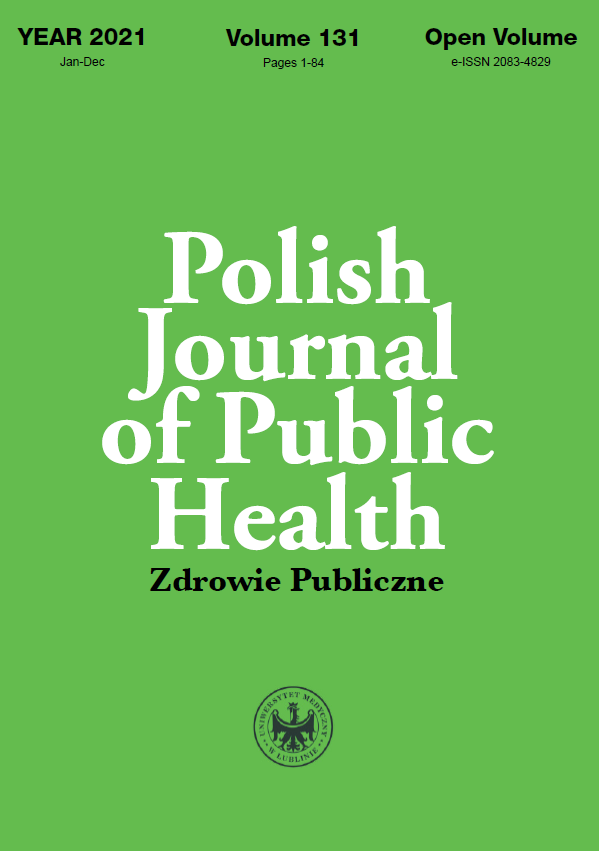Dental care in opinion of senior patients from Lublin
DOI:
https://doi.org/10.2478/pjph-2021-0008Keywords:
geriatric dentistry, dental care, seniorsAbstract
Introduction. The issues of dental office accessibility, professionalism of the service as well as treatment reimbursement often determine geriatric patients’ decision regarding treatment. In the era of an aging society, struggling with the intensification of disease processes of the entire system, the belief of the elderly about the value and availability of dental treatments is the key to the wide use of the achievements of modern dental medicine. Thanks to this, there is a chance to improve oral health, which will directly improve the overall health condition of this age group.
Aim. The aim of the study was to know the opinions of senior patients about the quality and availability of dental care for this age group.
Materials and methods. The study was conducted during the Lublin Seniors Meeting LUB-SENIOR 2019 among 100 randomly selected people of both sexes aged 60-75 living in Lublin, who are not residents of retirement homes. An anonymous direct questionnaire with 7 questions regarding dental care was used.
Results. After analyzing the answers given by the respondents (n=100), it was found that 84% of them showed satisfaction with the dental care available to them. Among the surveyed seniors, 81% declared having their own dentist, while 25% expressed the willingness to change him. As much as 80% of the respondents declared that dentists pay attention to seniors dental health problems. A friendly approach of the dental team to a senior patient was declared by 61% of the respondents. Preferences concerning the use of dental treatment in private offices were reported by 44% of thepeople, and within the procedures provided by the NHF – by 45%.
Conclusions. The surveyed senior patients show attachment to their dentist, while expressing a positive opinion on dental care and the treatment. Few people in the studied age group show the willingness to change dentists, which is directly influenced by the doctors’ interest in health problems of the elderly.
References
1. Knychalska-Karwan Z. Pacjent geriatryczny w gabinecie stomatologicznym.Mag Stomatol. 2004:14(7-8):11-4.
2. Prognoza ludność na lata 2014-2050. Główny Urząd Statystyczny. 2014.[https://stat.gov.pl/download/gfx/portalinformacyjny/pl/defaultaktualnosci/5469/1/5/1/prognoza_ludnosci_na_lata_2014_-_2050.pdf]
3. Black SA, Rush RD. Cognitive and functional decline in adults aged 75 and older. J Am Geriatr Soc. 2002;50(12):1978-86.
4. Wysokińska-Miszczuk J, Sieczkarek J. Gerostomatologia – uzasadnienia teoretyczne i przy-datność praktyczna w naukach medycznych. Twój Prz Stomatol. 2002;1(2):26-7.
5. Knychalska-Karwan Z. Zagadnienia stomatologii geriatrycznej. Mag Stom. 2000;10(12):10-2.
6. Barczak K, Szmidt M, Buczkowska-Radlińska J. Funkcjonalność narządu żucia a poczucie depresji u pacjentów po 55 roku życia zamieszkałych w środowisku rodzinnym i w domach pomocy społecznej. Psychiatr Pol. 2016;50(5):1027-38.
7. Chen CK, Wu YT, Chang YC. Association between chronic periodontitis and the risk of Alzheimer’s disease: a retrospective, population-based, matched-cohort study. Alzheimers Res Ther. 2017;9(1):1-7.
8. Wojtkowska AA, Wysokiński A. Wpływ zapalenia przyzębia na występowanie chorób układu sercowo-naczyniowego. Choroby Serca i Naczyń. 2015;12(5):289-94.
9. Barczak K, Buczkowska-Radlińska J, Witek A. Stan zębów i potrzeby lecznicze seniorów z ośrodków pomocy społecznej i domów rodzinnych w województwie zachodniopomorskim. Mag Stomatol. 2012;22(1):114-8.
10. Kaczorowski B, Gawriołek M, Siniawska J. Porównawcza ocena stomatologicznych po-trzeb pensjonariuszy Domów Opieki Społecznej z Poznania i terenu Wielkopolski. Dent Fo-rum. 2008;36(1):27-33.
11. Bagińska J, Chałas R, Rusyan E, Mielczarek A. Profilaktyka stomatologiczna – zalecenia dla osób starszych, rezydentów domów opieki i ich opiekunów. Stanowisko grupy roboczej Polskiego Oddziału Sojuszu dla Przyszłości Wolnej od Próchnicy (ACFF) ds. zapobiegania próchnicy w populacji osób dorosłych. Nowa Stomatol. 2020;3:82-92.
12. Preshaw PM, Mohammad AR. Geriatric dentistry education in European dental schools. Eur J Dental Educ. 2005;9(2):73-7.
13. Sytuacja zdrowotna pacjentów przebywających w zakładach opiekuńczoleczniczych, w zakresie opieki stomatologicznej. Rzecznik Praw Pacjenta; 2021. [https://www.gov.pl/web/rpp/sytuacja-zdrowotna-pacjentow-przebywajacych-w-zakladach-opiekunczo-leczniczych-w-zakresie-opiekistomatologicznej]
14. Wereda W, Jonczyk JA. The role of customer satisfaction in the modern marketing on the example of the market of dental services. Zeszyty Naukowe SGGW w Warszawie. Polityki Europejskie, Finanse i Marketing. 2016;16(65):114-27.
15. Kirenko J, Sienkiewicz E, Szymańska J, Malm A. Socjodemograficzne uwarunkowania sposobów radzenia sobie w sytuacjach trudnych przez personel pielęgniarski. Lubelski Roczn Pedagog. 2019;37(3):93-106.
Downloads
Published
Issue
Section
License
Copyright (c) 2021 Polish Journal of Public Health

This work is licensed under a Creative Commons Attribution-NonCommercial-NoDerivatives 3.0 Unported License.


